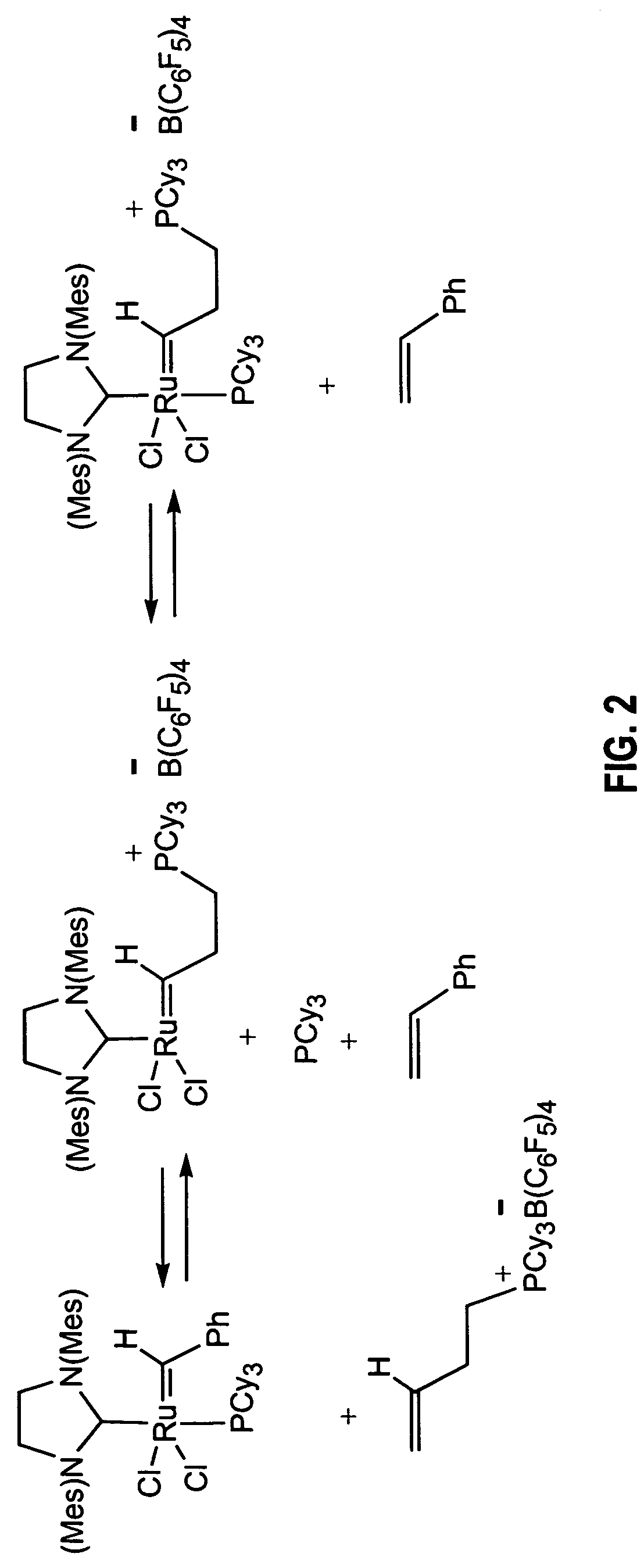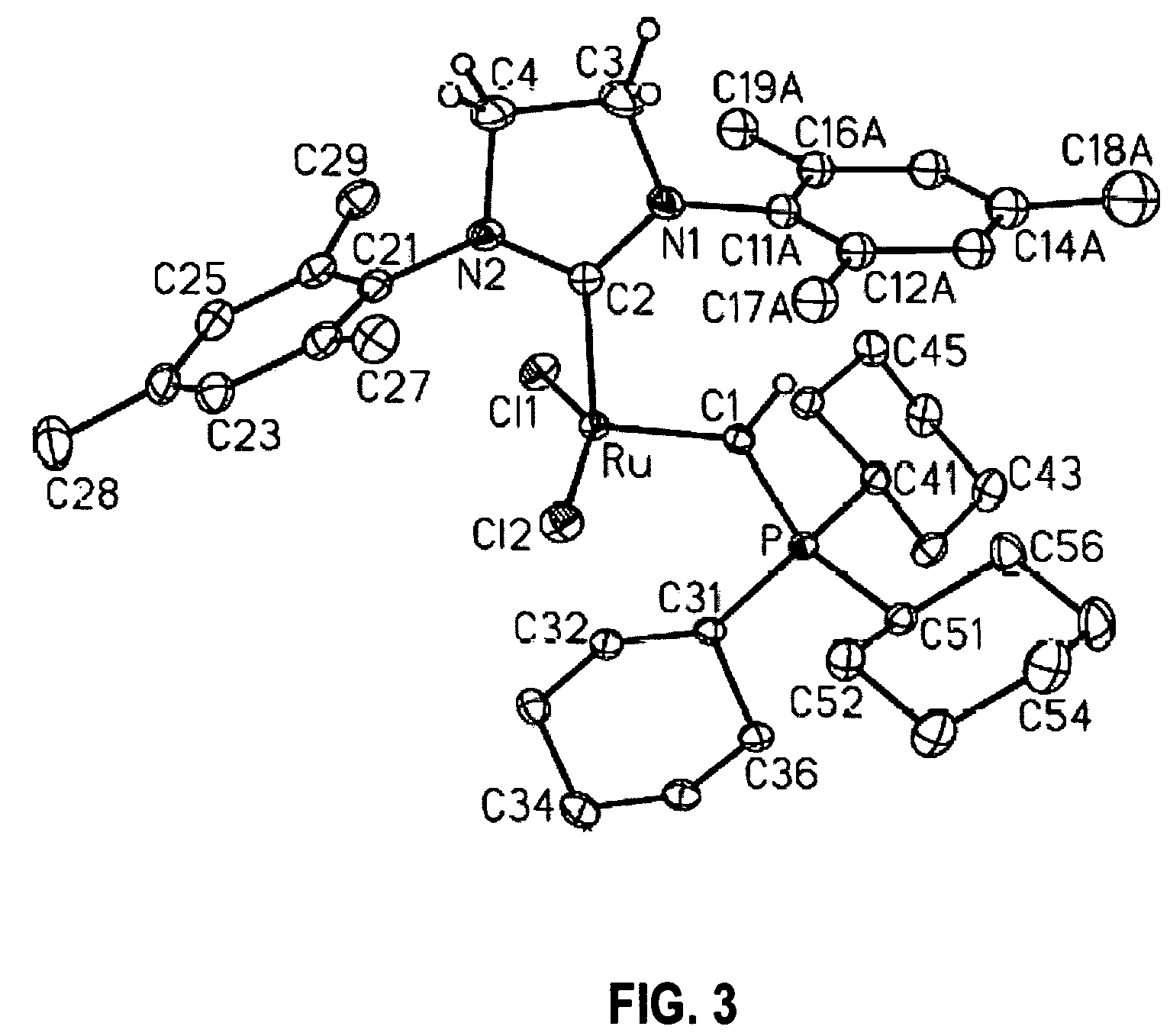Transition metal carbene complexes containing a cationic substituent as catalysts of olefin metathesis reactions
a transition metal and complex technology, applied in the field of transition metal complexes of new group 8 transition metal complexes, can solve the problems of increasing shortening so as to shorten the time to reaction completion, shorten the latency period of the metathesis reaction, and increase the rate at which the reaction occurs
- Summary
- Abstract
- Description
- Claims
- Application Information
AI Technical Summary
Benefits of technology
Problems solved by technology
Method used
Image
Examples
example 1
Preparation of (i-Pr3P)2Cl2Ru═C: (2a)
[0152]In the glovebox, a 50 mL round bottom flask equipped with a stir bar was charged with (i-Pr3P)2Cl2Ru═CHPh (1a, 1.00 g, 1.71 mmol), which was dissolved in ca. 15 ml of dry CH2Cl2. To this solution, 0.291 g (1.71 mmol) of Feist's ester dissolved in ca. 5 ml of CH2Cl2 were added at once via pipette with stirring. Within 1 minute, the color of the solution changes from purple to brown; stirring was continued for additional 20 minutes. The flask was then connected to a vacuum line and the solvent removed to dryness. Drying was continued for ca. 30 additional minutes to remove most of the styrene by-product. The flask was then opened to air and the solid residue was transferred to a sublimation apparatus, where the majority of the flumarate by-product was removed at 50-60° C. under dynamic vacuum for 1.5 hours. At this point some traces of organic material might remain (Feist's ester, styrene or fumarate, all 1H NMR (CD2Cl2, 25° C.): d 1.43 (dd, ...
example 2
Preparation of (Cy3P)2Cl2Ru≡C: (2b)
[0153]Using a procedure similar to the one outlined for 2a in Example 1, 2b was obtained in 90-95% yield. Spectral parameters matched those previously reported (i.e., by Carlson (2002) J. Am. Chem. Soc. 124:1580).
example 3
Preparation of (H2IMes)(Cy3P)Cl2Ru≡C: (2c)
[0154]In the glovebox, a 50 ml round bottom flask equipped with a stir bar was charged with (H2IMes)(Cy3P)Cl2Ru═CHPh (1c, 1.50 g, 1.76 mmol), which was dissolved in ca 20 ml of dry CH2Cl2. To this solution, 0.300 g (1.76 mmol) of Feist's ester dissolved in ca. 10 ml of CH2Cl2 were added at once via pipette with stirring. By contrast to the preparations of 2a-b, no immediate visible change was observed and the solution was stirred overnight (separate NMR experiments indicated that at this concentration, the reaction takes ca. 4 hrs. to reach completion). Work-up procedures were identical to those described above for 2a-b, resulting in a brown solid corresponding to pure carbide 2c was obtained. Yield: 1.22 g (90%).
PUM
| Property | Measurement | Unit |
|---|---|---|
| time | aaaaa | aaaaa |
| temperature | aaaaa | aaaaa |
| time | aaaaa | aaaaa |
Abstract
Description
Claims
Application Information
 Login to View More
Login to View More - R&D
- Intellectual Property
- Life Sciences
- Materials
- Tech Scout
- Unparalleled Data Quality
- Higher Quality Content
- 60% Fewer Hallucinations
Browse by: Latest US Patents, China's latest patents, Technical Efficacy Thesaurus, Application Domain, Technology Topic, Popular Technical Reports.
© 2025 PatSnap. All rights reserved.Legal|Privacy policy|Modern Slavery Act Transparency Statement|Sitemap|About US| Contact US: help@patsnap.com



